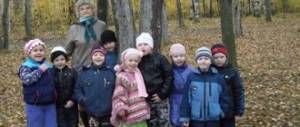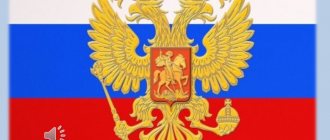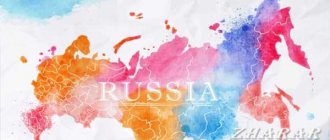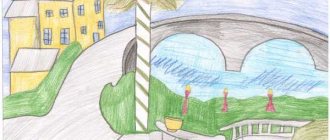Literary and musical composition “About Russia with Love”
Correctional education
Currently, one of the most pressing problems of correctional schools is the integrated education and training of children with developmental disabilities. This is due, on the one hand, to the democratization of all aspects of social life, and on the other, to the search for optimal conditions for the socialization of children with certain developmental disabilities. Integrated education and training provides children with developmental problems equal conditions with their healthy peers for maximum adaptation and full integration into society. At the same time, normally developing children may display a negative attitude towards a child who has functional abilities (ridicule, expressions of disgust). Due to manifestations of intolerance in the children's environment, it is quite difficult to introduce a child with limited functional capabilities into a group of normally developing peers. It is known that the problem of nurturing humane, friendly relationships in children's groups has always faced teachers. Therefore, for the successful implementation of integrated education, it is necessary to develop in schoolchildren with different functional abilities (with speech impairments OHP levels 1-2, hearing impaired, visually impaired) the ability to build interaction on the basis of cooperation and mutual understanding, willingness to accept other people, their characteristics as they are. In order to develop social and moral feelings in children, a readiness to understand other people, to have a tolerant attitude towards other people, a number of events were held together with secondary school students, which were built on the basis of cooperation and mutual understanding, in an atmosphere of mutual openness, goodwill, and demonstration of personal value each child, and not his shortcomings. One of such events, jointly held with secondary school students, was the literary and musical composition “About Russia with Love.” This is of particular interest to children, gives all participants the opportunity to feel confident and free to communicate with peers, develops in children feelings of patriotism and the ability to build relationships with each other. The presentation I compiled can be used both in class and during extracurricular activities. Using the presentation develops in children an interest in the history of Russia, the small Motherland, and makes it possible to feel a connection with all those relatives and friends that for all of us is included in the concept of Motherland.
Literary and musical composition “Russia is all I live by”
Literary and musical composition “Russia is all I live by” Song “Wide is my native country.” 1st reader. Russia – Rainbow and blue, Steppe gray wormwood, Scattering of fields, And snow, And ice, And a round dance of Birches soaring over the Volga. She is the crimson leaf fall, And again blue, And again the garden, And in it, captivating and long, A crazy nightingale rumbles. Russia - Clear dew, A stripe of slanting downpour, And the smell of lungworts from the meadow, The eyes of a child, The heart of a friend, The sadness of the evening sunrise. And the wide open distance From Seliger to Baikal. She absorbed everything, everything! Russia is everything I live by, what my soul strives for in dreams and in reality without getting tired. 1-presenter What a wonderful name - Russia! With this name we are kinder and stronger. In it is the wind of hope and the days of the front, And the rustle of birches, and the sadness of cranes. 2 - presenter What a wonderful name - Russia! The wind-covered forest and the silence of the fields. I bore this name in my heart, When I parted with my Russia. 1 - presenter Years pass over my country, Years pass over a great destiny, And if we are worth anything in life, It is only because our hearts are with you. 2 - presenter What a wonderful name - Russia! She gave us her kind character. All my life I only asked fate for one thing, So that Russia would be happy forever. Leading. Probably, every person who is able to feel like a part of their Motherland experiences a legitimate sense of pride when listening to poems and songs dedicated to their native land... Today we will talk about the history of our country, its symbols and think about how we feel about our Motherland , do we love her, can we dedicate some good and worthy deed to her. Each country has its own symbols, its own face... We see the image of the Eiffel Tower - we immediately imagine France, the Statue of Liberty - the USA... Symbols of Russia - the Moscow Kremlin and Red Square, St. Basil's Cathedral, the monument to Minin and Pozharsky, the Victory Banner... You name them - and it’s like you turn over the pages of history one after another, each of which is a feat of the people, their eternal desire for happiness, goodness, brotherly love, i.e. to the heights of the spirit. (At the same time, illustrations are being shown.) What symbols of the country do we know? 1st reader. The State Emblem, the State Flag and the State Anthem...These symbols are included in the Constitution of Russia, they are called state symbols. COAT OF ARMS OF THE RUSSIAN FEDERATION State coat of arms of Russia (coat of arms translated from German - heritage, inheritance). - a red quadrangular heraldic shield, the lower corners of which are rounded and the tip is pointed. On the shield is a golden double-headed eagle. The eagle's wings are raised up and spread out. Eagle heads are crowned. In the center above them is a large crown. The crowns are connected by ribbons. In the eagle’s right paw is a scepter (golden rod), and in the left is an orb (golden ball). On the chest of the eagle in a red shield is a silver rider in a blue cloak on a silver horse. Under the horse’s feet is a black dragon overturned on its back. In the horseman's hand is a silver spear, with which he hits the dragon. The double-headed eagle is a symbol of the unity of the peoples of Russia; his crowns are symbols of the union of republics, territories and regions. The scepter and the orb mean the strength and power of a single state. The rider on the shield is the personification of victorious good, the readiness of the people to defend the country from enemies. FLAG OF THE RUSSIAN FEDERATION The national flag of Russia is a rectangular panel of three stripes: the top is white, the middle is blue and the bottom is red. In Russia, these colors have long been revered and had a symbolic meaning: white - nobility, perfection. Blue – should be understood as the desire for heaven, constancy, fidelity; red color symbolizes human virtues: courage, valor, heroism. The white-blue-red national flag was first flown on a ship of the Russian Navy under Peter I. Shows a portrait of Tsar Peter.) The flag stripes of the same width are arranged horizontally. For the State flag, the ratio of the width of the cloth to its length is 2:3. We celebrate the Day of the State Flag of Russia on August 22. Presenter. But what about the red banner and what place does it have in modern Russia? 1st reader. The red banner is an attribute of the Russian Armed Forces. With him, our army went through a long and heroic path in the Great Patriotic War, won a historic victory over the most powerful army in the world, which collected military-technical potential and human reserves from all over Europe. The Russian Navy also has a banner. This is the blue and white St. Andrew's banner. (The presenter shows a postcard with an image of St. Andrew’s Banner.) By the way, who knows where this word – banner – came from? And it comes from the same root “sign”, “sign”... Songs were often composed about the battle banner, about the heroism and sacrifice of our soldiers, which do not fall into oblivion. Leading. Are there other state symbols besides the flag coat of arms? 1st reader. National anthem! The national anthem is a solemn musical and poetic work. It is performed on especially solemn occasions (at meetings and farewells of heads of state, during parades, major public holidays). During the solemn performance of the anthem, it is listened to while standing, people turn towards the State flag, men take off their hats. Everyone present stands up, and the military salutes. Hymn translated from Greek is a solemn song of praise, or praise, performed on special occasions. The melody of our anthem was written by Alexander Vasilyevich Alexandrov. His music is known and respected all over the world, it gives rise to pride in our country. This corresponds to the words of the anthem written by Sergei Vladimirovich Mikhalkov. They contain the idea of revival, greatness and glory of Russia. The modern anthem unites all the people of our country, all those who love their Motherland and are proud of it. (The Russian anthem plays) Reader. There is no more beautiful land in the world, There is no brighter homeland in the world. Russia, Russia, Russia, What could be dearer to the heart? Who was equal to you in strength - Anyone suffered defeat. Russia, Russia, Russia, We are with you in sorrow and happiness. And if we were suddenly asked: “Why is the country dear to you?” - Yes, because for all of us, Russia, like a dear mother, is one! Leading. . Where does the Motherland begin? This is not an easy question. First of all, this is the place where you were born and grew up, where you studied, worked, where you made friends... The homeland is your native land, the one that has been dear to us since childhood! Song “Where the Motherland Begins”
Leading. There are many beautiful and even unusual places in Russia. But the most beloved and dear to the hearts of each of us are the places connected by our small homeland - Ossetia. Its land is washed with the blood of our great and heroic ancestors. That is why she is dear to the heart, that is why she is infinitely loved! Nature has generously gifted Ossetia. Majestic mountains covered with eternal snow, restless waterfalls, dark deep gorges, light green valleys, glaciers, unique alpine meadows, silvery threads of rivers, rushing springs ringing with crystal purity - all this creates an amazingly beautiful picture. And Terek? It is impossible to imagine this region without the river. Gathering mountain streams, the Terek gains new strength From its snowy sources to the edge of Buren, rebellious and beautiful. My land is pure, irresistible! Trees, rivers, mountains, home... You have everything - both beauty and strength... OSSETIA, I bow to you!!! Leading. And our Ossetia has its own anthem, flag and coat of arms. They are needed as the embodiment of its history and a reflection of the present, as an expression of the patriotism of its citizens and designation in the international arena, as its visual and musical image. 1st reader. The coat of arms of North Ossetia-Alania is an image of a leopard against the backdrop of mountain ranges. “The state emblem of the Republic of North Ossetia-Alania is associated with the heraldic sign of the era of public state unity and is a round heraldic shield in a scarlet (red) field; a golden leopard with black spots walking on the golden ground; behind him are seven silver mountains (one, three and three).” On the coat of arms, the leopard and the ground on which he walks are golden. The background is seven mountain peaks arranged in three rows. The mountains on the shield symbolize the World Mountain, the oldest model of the world among the ancestors of the Ossetians and other Indo-European peoples. Silver color means purity, wisdom, joy. The entire composition of the coat of arms is placed in a round (eastern) shield of scarlet, that is, red, symbolizing right, strength and courage. 2nd reader. The state flag of the Republic of North Ossetia-Alania is a rectangular panel consisting of stripes of white, red and yellow colors arranged horizontally in sequence from top to bottom, each one-third the width of the flag. The ratio of the width of the flag to its length is 1:2. White color - emphasizes the spiritual purity of the people, their high morality, therefore it occupies the highest place on the flag. The color red in heraldry has always symbolized courage, valor, and readiness to defend one’s homeland. In this capacity, he occupies the middle stripe of the flag. Yellow color is a symbol of abundance and grace. 1st reader. The national anthem is the treasury of its national culture. The anthem of North Ossetia-Alania was adopted by a resolution of the Supreme Council of the Republic of North Ossetia-Alania on November 24, 1994. “The national anthem of the Republic of North Ossetia-Alania is a symbol of the state, the preservation of the traditions of national culture, and the unity of the multinational people of the republic.” (the anthem of Ossetia sounds) Zærin khur yæ tyntæ nyvændy fælmæn Næ fyælty ragon uæzægyl rædauæy, Arvy byn kala færdygau tæmæn Iryston yæ adæmty farnæy. Zamanty taræy ærttivy zyngau Dæ uidag, næ Ivguyd, næ Abon, næ Fidæn. Barvæs næ kuyvdyl, Khuytsæutty Khuytsau, Uastirdzhi, rafælgæs, Tabu Dækhitsæn. (etc.) Host: Today we talked about our Motherland, its symbols, and have you thought about how we ourselves relate to our Motherland, do we love it, can we dedicate some good and worthy deed to it? (Speech by children) Presenter: To become a worthy citizen of his homeland, every person must do a lot of work on self-education and acquiring civic qualities. And civic qualities are manifested not only and not so much in his words, but mainly in his real deeds. What things await us in the future? You should think about this more and more often. And if you are a real citizen, the country expects great returns from you. And raise, in spite of thoughtlessness, Your determination to fight to the end. And maybe everything that is called the future depends on your hand.
Leading. Yes, we are all residents of a wonderful, rich country. Our Motherland is Russia. Each of us should know the state symbols that we got acquainted with today. They not only absorbed the history of the people and their traditions. We got these symbols at a high price. Whether we will respect our heritage, protect and cherish it, as our ancestors did, time will tell. Here I would like to recall the words of the philosopher V. Rozanov, who said that it is easy and pleasant to love the Motherland in the days of its great glory, but the one who serves it in the days of sorrow and trials is worthy of respect. The song “My Motherland” is playing.





